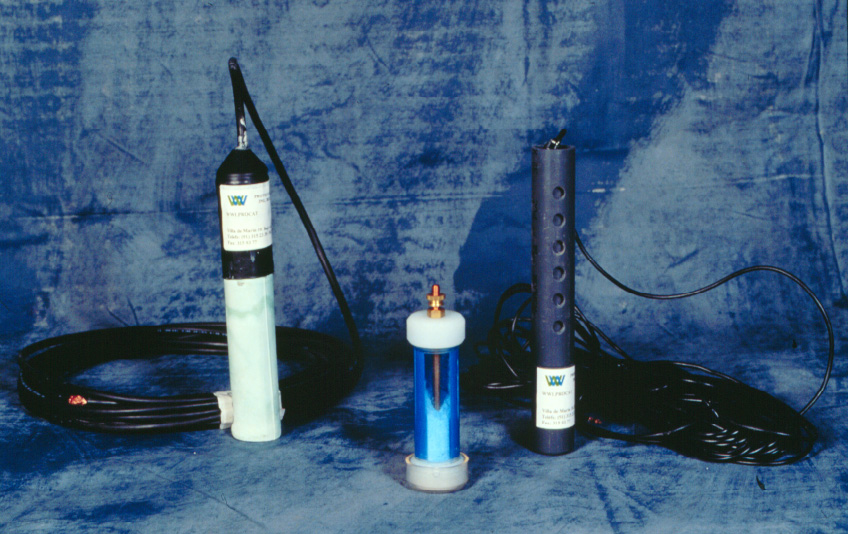Cathodic protection is a corrosion protection system widely used today both in the marine field as well as in industry.
This procedure is based on the electronegative polarization of a metal surface until a degree of polarization is reached where the surface of the metal becomes immune to corrosion.
According to Pourbaix, in their studies on the electrochemical equilibrium of steel, the state of immunity of this metal takes place when the solubility in the electrolytic is under 10-6 atom-grams per liter, i.e. 0.056 mg/l. This corresponds to a dissolving potential, with respect to the standard 1N hydrogen reference electrode of -530 mV. Steel has, under natural conditions, a dissolving potential near -300 mV, with respect to the same reference electrode, which varies depending on the chemical nature and physical conditions of the electrolyte (temperature, for example).
The hydrogen electrode is only used in laboratories since it is so fragile. In the field of cathodic protection a saturated Cu/CuSO4 (CSE) or Ag/AgCl electrodes are used or an electrolytic Zn with a purity of 99.99%. Another reference electrode is the calomel electrode, although its normal use is in laboratories. The Cu/CuSO4 electrode is the most common for measuring potentials of buried metals, being -850 mV the generally accepted immunity potential for this electrode. When the electrolyte is sea water, a Ag/AgCl electrode is usually used, being -780 mV the immunity potential for this electrode.
In order to obtain the desired polarization of the metal surface being protected, a pure direct current is applied to the surface, through the use of a galvanic battery or through a rectified and filtered alternating current.
If the first of these two systems is used (galvanic battery) a cathodic protection by "GALVANIC ANODES" is obtained. When a rectified current is applied, the protection is referred to as "IMPRESSED CURRENT".
CHOICE OF PROTECTION CATHODIC PROTECTION SYSTEM
The choice, between Impressed Current and Sacrificial Anodes will usually depend on economic reasons, although sometimes technical reasons will make one more recommendable than the other.
GALVANIC ANODES
The advantages or disadvantages of the sacrificial anodes may be:
• They imply a grounding of the pipeline, thus mitigating the problem of induced voltages.
• They do not provoke the problems of eddy currents in other structures or nearby pipelines (for example, their use is advisable in urban areas where there is a large density of steel pipe).
• They have a better behavior against eddy currents if they are not too intense, because if they were very intense the number of anodes required would make the system unfeasible.
• They are easier to maintain since they do not depend on any electric devices, fuse cables, etc.
• They have a lower cost when the installation is small or when there is little need for current.
• They have the disadvantage of needing multiple connections to the pipeline. In the case of a short pipe, just a few connections would be necessary such as the case for the connection to a LPG tank.
DIFFERENT KIND OF GALVANIC ANODES
• Mg: there are two typically alloys, one is the more used, the alloy of Mg with a little quantity of Al ( 6%) and Zn (3%), with a potential vs CSE -1,55 V ant other (named of High Potential) with -1,75 V vs CSE, is Mg almost pure alloyed with a little quantity of Mn.. The magnesium anode is the more commonly used in earth. The magnesium anode could be installed bare only in water and buried where the resistivity of soil is lower than 2,000 Ohms S x cm, and homogeneous. In other cases these have to be backfilled with a mixed of gypsum, bentonite and Na2SO4.
• Zn: this is an alloy of Zinc almost pure (starting with a Zinc of 99.99 purity), alloyed with a little quantity of Cd. It is used normally in sea water and earths with very low resistivity (usually backfilled). The maximum temperature supported is about 50ºC.
• Al: It is and alloy of Al (starting with an Al of a purity of 99.99%) an, a little of In. For high temperatures is necessary alloying also with Bi.
IMPRESSED CURRENT
• Only one connection is needed to the pipeline or structure being protected.
• Fewer anodes are required which can reduce the cost of the civil works (the opening and closing of ditches).
• A much greater negative potential can be given to the cathode if the case may be (for example, when stray currents are very intense).
• It is cheaper for longer or badly surface coated pipelines that need a lot of current.
• They may cause stray currents in other pipelines, cables, etc. that are found nearby.
• They may provoke the cathodic disbonding (blistering of coating) due to the forming of hydrogen under the surface coating of the pipe.
• It is advisable that low voltage in steel with elastic limit is #800 N-mm² the damage may be caused to the steel hydrogen embrittlement (for example in the prestressed reinforced concrete)
From our point of view, it has always been an error to intersperse balance resistors between the connection to structures to be protected with the same T/R units and groundbeds. On the contrary, our idea is that the return resistance from the CP system should be as little as possible in order to prevent the current from having the tendency to leave some structure to the ground and return to the cathode directly connected to the negative pole of the T/R
Therefore, the balance for current distribution should always be at the anodes, in such a way that, in addition to being able to improve the distribution of this current, a balance in output currents from the different anodes in each groundbed and between the different groundbeds is obtained (there should always be an enclosure or connection box with balance resistors).
ANODES TO BE USED ON IMPRESSED CURRENT SYSTEMS
The following types of anodes are usually used for Cathodic Protection with buried anodes, (a duration of 20 years are usually calculated for the anodes):
• Graphite: This is the oldest anode (starting whit it in Europe in the years 40 th and the next 50 th in USA). The most common size used is 75 mm N x 1,500 mm, with a 1 to 1.5 A output current, and have an expected life of around 20 years (weighing 12 kg, with an approximate consumption between 0.2 and 1 kg/A per year depending on the media and the anodic current density). Problems with these anodes: As far as cost is concerned these days, they offer no advantage when compared to others, since their price is about the same. They are fragile, however, but light weight for easy installation. In ground with a low resistivity and a lot of output current, they usually suffer the so-called "ending effect", rapidly losing their connection at the head.
• Fe/Si and Fe/Si/Cr: This kind of anode started in Europe with it in the 50 th years en 60 th year in USA. Two sizes are commonly used, one which is 50 mm x 1,500 mm (weighing 22 kg, with a recommended a output current of 2 A, and a an expected life of 20 years), and the other which is 75 mm x 1.500 mm (weighing 54 kg with a recommended a output current of about 3,3 A, and a duration period of 20 years). For deep groundbed installations, the tube shaped anode is usually used, but even though it is less weight it has the disadvantage of less duration (an approximate consumption between 0.1 and 0.9 kg/A per year). Fe/Si/Cr anodes are recommended when the ground has a high chloride content. Problems with these anodes: As far as cost is concerned these days, they offer no advantage when compared to others, since their price is about the same. They are very fragile, and heavy for handling. In ground with a low resistivity and with a lot of output current, they usually suffer the so-called "ending effect", rapidly losing their connection at the head.
• Ti-MMOX (or DSA): These anodes come in a strip form (between 0.5 and 3 m long, 20 mm wide and 3 mm thick) or tube shaped with 16 mm or 25 mm diameters, a 1 mm wall thickness and a length between 250 mm and 1,500 mm. Problems with these anodes: In some media where there is a high chloride content, they have a maximum voltage limit (in sea water 9.5 VDC, in other media with less chloride the voltage may be increased and they usually show none of these types of problems in normal ground). Advantages with these anodes: This type of anode is being used more and more everyday due to its competitive price in comparison with the Fe/Si or graphite anodes. They also give much higher output currents with an expected life of 20 years (about 100 A/m² in carbon backfill). Furthermore, transport and installation is much less (a 20 x 3 x 1000 mm anode, which weighs about 0.3 kg, without cable, may give up to 4 A with a 20 year duration), and they do not suffer the so-called "ending effect".
BASIC EXPLANATION OF "ENDING EFFECT"
Logically the distribution of current through the length of the anode is never perfect not totally homogeneous due to the connections on one end and the output current circulating through it before it leaves and enters the ground causing a drop in the voltage over the length of the anode. A greater drop in current will be found when the output current is greater. If the ground in contact with the anode has a low resistivity, the current will always preferably tend to leave, through the end connected to the anode, and even more so in this case, thus this area is consumed first. Several different approaches have been made to try to solve this problem such as making the connection at the center of the anode (for graphite anodes), but often the same thing occurs even though at a later date (the ending effect usually has the affect of anode loss after about 1 or 2 years), consuming the anode in the central area first. Another solution, for Fe/Si and Fe/Si/Cr anodes, adopted is to connect the anode at both ends, thus reducing the effect taking longer to occur, but inevitably the ending effect often occurs before the expected service life of the anode has been reached. Still another attempt has been made to enlarge the diameter of the end where the anodes are connected (today, all Fe/Si anodes usually made this way), but since the problem was not completely prevented a plastic cap was added to insulate the end or head. The consequence of this action is that the anode is consumed at the point where the protective insulation stops, which is where the current begins to leave the anode into the ground.
The Ti-MMOX or Ti-DSA anodes (Dimensionally Stable Anode), so-called by their inventor Mr. Charles Potosnak (the WWI Engineer who presented these anodes in the International Corrosion and Cathodic Protection Congress of Zaragoza in 1976), and at one of the meetings of the CEN 219), do not have this problem due to the fact that titanium does not act as an anode and therefore does NOT DISSOLVE. In these anodes the material that dissolves is the precious metal mixed oxides in the coating (MMOX), thus the metal support for the anode is not lost.


